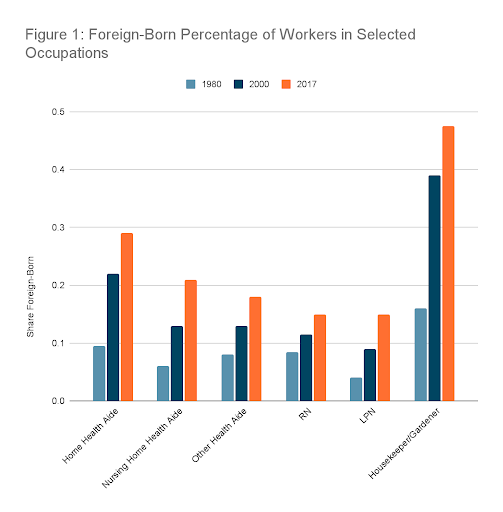The U.S. Census Bureau projects that the number of people aged 65 or older will exceed 73 million by 2030 and 94 million by 2060. By 2034, this population will outnumber the under-18 population for the first time in history. Many among this growing cohort of people aged 65 and up want to remain in their homes and will have to rely on the fast-dwindling supply of home health care workers to do so. In this decade alone, the U.S. Bureau of Labor Statistics expects the demand for home health care labor to grow at a much faster rate on average than the total job market — and that demand will be satisfied almost entirely by foreign workers.
Surveys suggest more than 75 percent of individuals over 50 want to remain in their homes as they age. Immigrants make up a quarter of care workers, with these numbers expected to rise given that Americans show a general unwillingness to accept these positions. Immigrant home health care workers will most likely need to answer the call to fill these increased labor needs. To make that possible, immigration policies such as the J-1 visa Au Pair program or the discontinued H-1C program will need quick reforms.
A new paper by economist Kristin Butcher and co-authors sheds light on the impact immigrant labor has on the aging choices of older Americans. Butcher et al. find a positive correlation between the likelihood that people 65 and older will choose to age at home and the density of available immigrant labor. They also find that the legal status of these immigrants affects these aging choices.
The authors categorize in-home care as “labor-intensive,” since a care worker can usually only assist clients residing at a single residence. That also makes it highly susceptible to fluctuations in the local availability of labor. The growing immigrant share in occupations crucial to in-home care, such as gardening and housekeeping, has allowed it to become a more affordable option for people to consider as they age.
These findings correspond to the authors’ conclusion that “a typical US-born individual over age 65 in the year 2000 was 10 percent less likely to be living in an institution than would have been the case if immigration had remained at 1980 levels.” In areas with higher availability of immigrant labor, older Americans are more likely to remain at home — something that they overwhelmingly want to do — and hire in-home care.
It is critical, then, that enough labor be available to fill these needs. However, native-born Americans have proven resistant to filling these positions, or when they do, prefer to work only normal business hours, leaving immigrants to fill early, late, and overnight shifts. A major reason for this is low wages. Average hourly wages for home health aides are between $12 and $14 an hour, with the median annual income less than $15,000. The partial result of this resistance is seen in Figure 1, which shows that the share of immigrant labor in multiple fields related to in-home care rose dramatically from 1980 to 2017.

However, our increased reliance on immigrant labor for America’s seniors has not corresponded to any policy reforms that would allow for more foreign-born home health care workers to immigrate to the U.S. The U.S. does not have any visa categories designed for either nonimmigrant or immigrant home health care workers — the foreign-born now working in those fields arrived through different immigration channels.
Without reform it will be difficult to bring in the necessary number of immigrant laborers to help America’s seniors thrive, meaning not only that fewer Americans will be able to age at home, but that care facilities may be forced to shut down.
One possible reform is to reinstate and modify the H-1C visa program by adding home health aides as a qualified occupation in addition to nurses. The underutilized program, which was discontinued in 2009, allowed for foreign nurses to come to the U.S. for up to three years to work in areas that had nursing shortages.
Another possible reform is to include elder care as an option in the J-1 visa Au Pair program or to create a separate qualification that focuses solely on elder care.
Of course, such proposals must contend with the rise of anti-immigrant sentiment in contemporary U.S. politics. Although anti-immigrant trends have been present for decades, the former Trump administration brought these feelings to mainstream political discourse, leading to uncertainty over the increase of immigrant labor. Even after the end of the Trump administration, these ideas continue to influence and attract adherents. Yet, immigrant laborers continue to do the crucial work to help American seniors thrive and act as key contributors to the U.S. economy and society. They have demonstrated that their work and contributions are not only necessary, but valuable additions to the U.S. labor force. It is in this environment that these needed reforms will be attempted — with quality of life on the line for millions of older Americans.